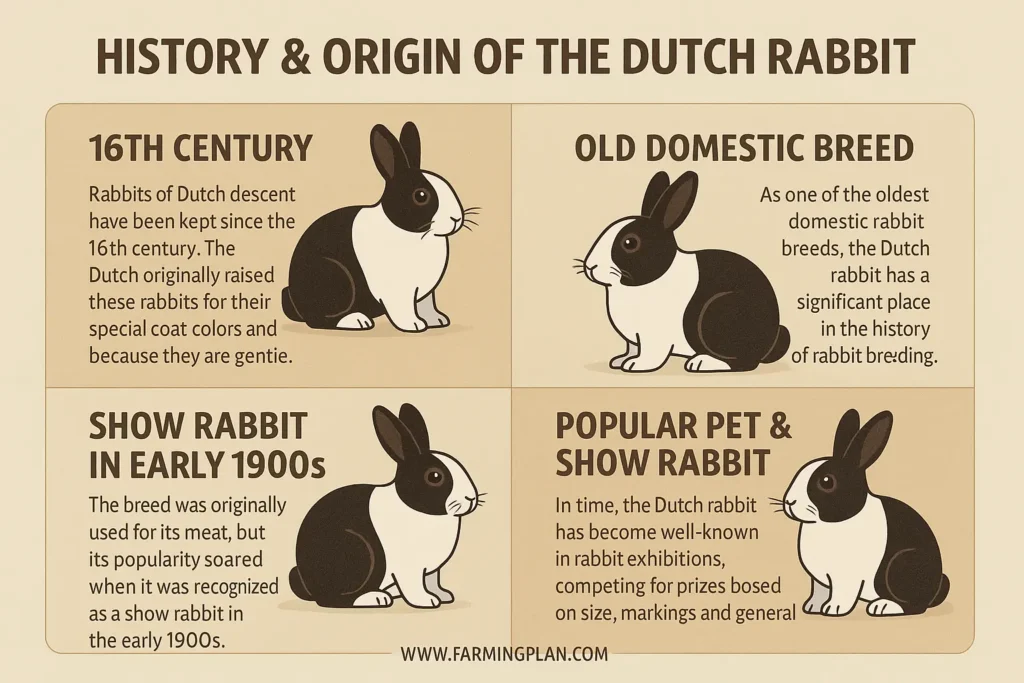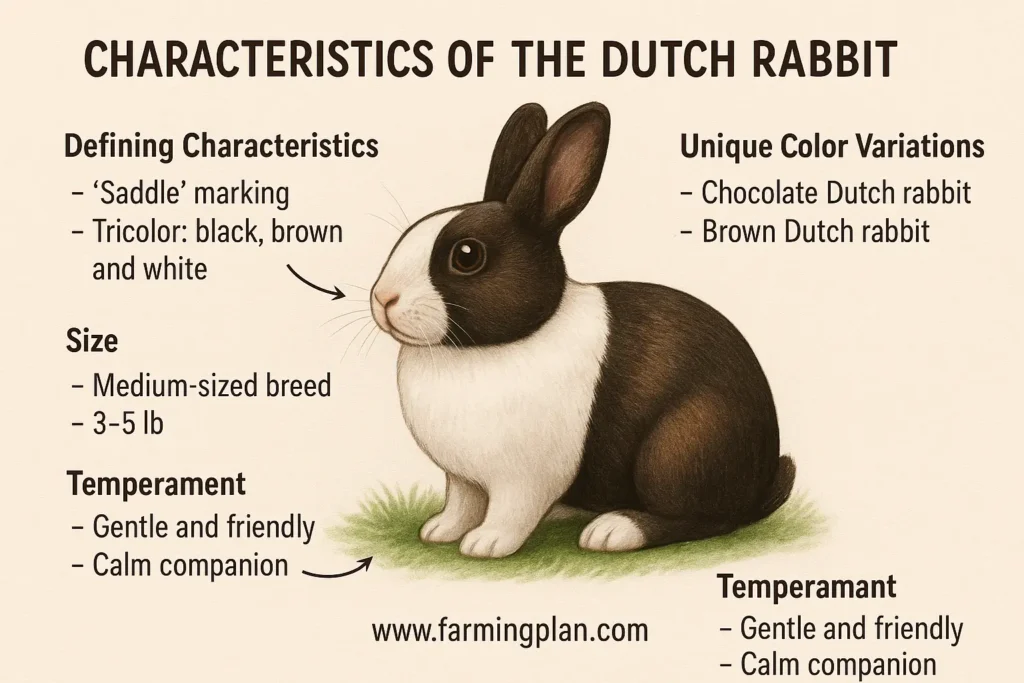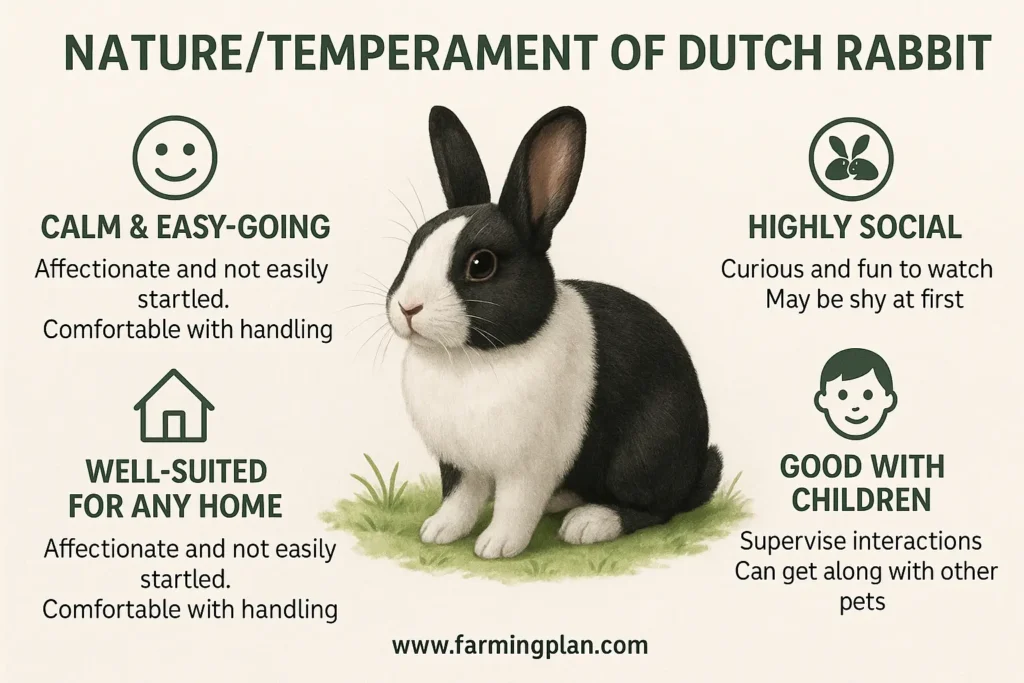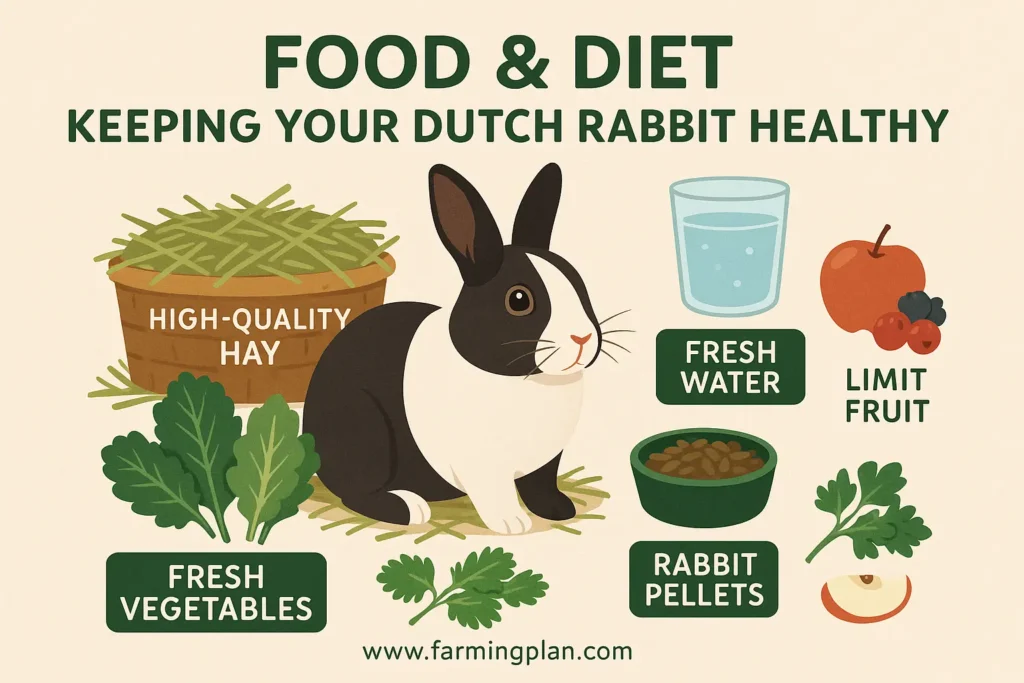If you’re looking for a lovable, easy-going rabbit to add to your family, the Dutch rabbit might be the perfect choice! Known for their striking markings and friendly nature, Dutch rabbits are one of the most popular rabbit breeds. Whether you’re a seasoned pet owner, a rabbit breeder, or simply considering getting your first bunny, understanding the unique traits of the this rabbit is essential. In this guide, I’ll walk you through everything you need to know—from their history and temperament to how to care for them properly. Get ready to learn all about this charming breed and why Dutch rabbits make great companions for pet lovers of all kinds!

History & Origin
Rabbits of Dutch descent have been kept since the 16th century. The Dutch originally raised these rabbits for their special coat colors and because they are gentle. Europe took to their music soon and before long their popularity spread across the North Atlantic region as well. They claim that in the Netherlands, the breed was specially bred for its beautiful coat and gentle attitude.

As one of the oldest domestic rabbit breeds, the Dutch rabbit has a significant place in the history of rabbit breeding. The breed was originally used for its meat, but its popularity soared when it was recognized as a show rabbit in the early 1900s. Today, This rabbits are cherished primarily as pets, known for their recognizable “saddle” markings and their calm, friendly demeanor.
In time, the Dutch rabbit has become well-known in rabbit exhibitions, competing for prizes based on size, marks and general condition. These rabbits have become popular pets and are visible at rabbit shows, exciting many enthusiasts.
Characteristics of the Dutch Rabbit
Dutch rabbits are easily identifiable due to their unique color markings and compact, muscular build. One of the most defining characteristics of the breed is its “saddle” marking, which is a distinct color pattern across its back, resembling a saddle. These rabbits typically feature a white belly with colored fur on their back and sides, with the most common color being a mix of black, brown, and white. Their short, smooth fur makes them relatively easy to groom, making them a low-maintenance breed.

In terms of size, Dutch rabbits are considered a medium-sized breed. Adult rabbits typically weigh between 3 to 5 pounds, making them manageable in size for most households. Their round faces, large ears, and expressive eyes add to their adorable appearance. The breed’s unique color variations, such as the popular chocolate this rabbit and the brown Dutch rabbit, make them stand out in any group of rabbits.
One of the most remarkable traits of Dutch rabbits is their temperament. They are known for being gentle and friendly, making them a great choice for families or individuals looking for a calm companion. These rabbits are social animals that enjoy interacting with their owners and thrive in environments where they receive plenty of attention and love.
Read More: American Sable Rabbit: Perfect Pet With A Gentle Heart
Nature/Temperament
Dutch rabbits are widely known for their calm and easy-going nature. They are affectionate and enjoy being around their human companions. Unlike some other rabbit breeds, this rabbits are not easily startled and tend to be quite comfortable with handling. This makes them a perfect choice for both first-time rabbit owners and experienced breeders.

These rabbits are highly social and do best when they receive plenty of interaction. They are often curious and will enjoy exploring their environment, making them fun pets to watch. However, they can be a bit shy at first and may need some time to warm up to new people. Once they become accustomed to their surroundings, Dutch rabbits are typically very affectionate and bond closely with their owners.
While they are known to be good with children, it’s important to always supervise interactions to ensure the rabbit’s safety. This rabbits can also get along well with other pets, provided that they are introduced carefully and given time to adjust. Their calm demeanor makes them well-suited for both indoor and outdoor living, as long as they are protected from extreme weather conditions.
Food & Diet Keeping Your Dutch Rabbit Healthy
Caring for a Dutch rabbit’s diet is essential to ensuring they live a long, healthy life. Dutch rabbits, like all rabbits, require a balanced diet that includes high-quality hay, fresh vegetables, and rabbit pellets. Hay should make up the majority of their diet, as it provides the necessary fiber for their digestive health. Timothy hay is the most commonly recommended type, but other varieties like oat or meadow hay are also excellent choices.

In addition to hay, Dutch rabbits enjoy a variety of fresh vegetables. Some of their favorites include leafy greens like kale, romaine lettuce, and parsley. It’s important to offer a mix of vegetables each day, but you should avoid feeding them too much fruit or high-sugar vegetables like carrots. A few treats like a small slice of apple or a few berries can be given occasionally but should not be the main part of their diet.
Rabbit pellets are a great source of vitamins and minerals, but they should be given in moderation to avoid overfeeding. Fresh, clean water should always be available to keep your Dutch rabbit hydrated. Just like with any pet, it’s important to ensure that they receive a balanced diet to maintain optimal health.
Usage/Purpose
The Dutch rabbit is primarily kept as a pet, but it also has a long history in rabbit farming and exhibitions. Originally, these rabbits were bred for their meat, but their stunning appearance and gentle temperament soon made them more desirable as pets. Today, Dutch rabbits are most commonly found in households around the world, where they are kept as beloved companions.
In addition to being great pets, Dutch rabbits are also highly prized in the world of rabbit shows. Their distinctive markings and even temperaments make them a popular breed among exhibitors. These rabbits are often seen at various competitions where they are judged based on their appearance, health, and overall condition. If you’re looking to show rabbits, the Dutch breed is a great choice for both beginners and experienced breeders alike.
Their calm nature also makes them suitable for therapy work. Many rabbits are used in pet therapy programs, where they bring comfort and joy to individuals in nursing homes, schools, and hospitals. Whether as a pet, a show rabbit, or a therapy animal, the this rabbit’s versatility makes it a truly special breed.
Read More: Checkered Giant Rabbit: A Gentle Giant Breed
Special Features of the Dutch Rabbit
Dutch rabbits are full of unique features that set them apart from other rabbit breeds. One of the most notable features is their striking coat markings. The “saddle” marking, where the body color is distinct from the white fur on the belly, is a trademark of this breed. Their coat colors range from classic black, brown, and chocolate, to variations with grey or steel tones. The rabbit’s eyes are often ringed with white, giving them a bright, expressive look.
Another interesting feature of Dutch rabbits is their calm, friendly temperament. While many rabbit breeds can be skittish or difficult to handle, the Dutch rabbit is typically much more relaxed and adaptable. Their easy-going nature makes them excellent pets for first-time rabbit owners or anyone looking for a rabbit that enjoys spending time with its human companions.
Despite their small size, Dutch rabbits are strong and active. They love to hop around, explore, and even jump into high places. Their playful yet calm disposition makes them a great fit for both indoor and outdoor living, as long as they are provided with enough space to move around.
Read More: Cashmere Lop Rabbit: The Ultimate Adorable and Devoted Pet
Health Issues & Prevention
Like all animals, Dutch rabbits are prone to certain health issues, but with proper care and preventive measures, these can be minimized. One of the most common health concerns in rabbits is digestive issues, which can arise if they don’t receive a balanced diet. Ensuring that your Dutch rabbit has access to plenty of fresh hay and water is key to preventing digestive problems.
Respiratory infections can also affect rabbits, especially if they are exposed to drafts or kept in damp, unclean environments. It’s important to keep your rabbit’s living space clean and dry, with good ventilation. Regular checkups with a veterinarian who specializes in rabbits are essential for catching any potential health problems early.
Another common concern for rabbits is dental health. Rabbit teeth grow continuously, so it’s important to provide chew toys and plenty of hay to help wear down their teeth. Overgrown teeth can lead to pain and difficulty eating, so be sure to monitor their dental health regularly. Overall, with proper care, this rabbits can live healthy, happy lives.
“Love Your Dutch Rabbit Like A Family Member, And They’ll Return The Favor With Their Gentle Nature And Loyal Companionship!”
Step-by-Step Pet Owner Care Guide
Taking proper care of your Dutch rabbit involves setting up a suitable living space, providing a balanced diet, and maintaining regular grooming and health checks to ensure a happy and healthy life.
Step 1: Setting Up Your Dutch Rabbit’s Home
- Choose a spacious, clean cage for your Dutch rabbit. The cage should allow plenty of room for movement and be equipped with a water bottle, food bowl, and litter tray.
- Place the cage in a quiet area of your home, away from direct sunlight and drafts.
Step 2: Feeding and Hydration
- Ensure your Dutch rabbit has access to fresh hay at all times. Supplement this with fresh vegetables daily and provide a small amount of high-quality rabbit pellets.
- Offer fresh, clean water in a bottle or bowl at all times.
Step 3: Grooming and Health Checks
- Brush your Dutch rabbit regularly to keep its coat shiny and free from tangles. Even though their fur is short, brushing helps with shedding and skin health.
- Check your rabbit’s ears, eyes, and teeth regularly for signs of infection or overgrowth.
Expert Tips & Best Practices
To ensure your Dutch rabbit thrives, make sure you spend plenty of time bonding with it. Dutch rabbits love companionship and thrive when given attention. Additionally, offer a variety of toys to keep them mentally stimulated. Consider creating a “whisker bed” for your rabbit, which provides a comfortable spot for them to retreat when they need a break.
Where to Buy Dutch Rabbit
If you’re ready to welcome a Dutch rabbit into your home, it’s important to buy from a reputable breeder. Many rabbit breeders specialize in Dutch rabbits and can provide you with a healthy, well-socialized bunny. Ensure that the breeder provides proper health records and that the rabbit has been raised in a clean, safe environment. You can also check local animal shelters, where rabbits are often available for adoption.
FAQ
What is the lifespan of a Dutch rabbit?
Dutch rabbits typically live for about 5 to 8 years when well cared for.
Are Dutch rabbits good pets for children?
Yes, Dutch rabbits are friendly and social, making them great pets for families with children. However, always supervise young kids during interactions.
Do Dutch rabbits require a lot of grooming?
No, Dutch rabbits have short fur and require minimal grooming, but regular brushing helps maintain their coat’s health.
How much space do Dutch rabbits need?
Dutch rabbits need a spacious cage and access to a secure area to hop around and play.
What should I feed my Dutch rabbit?
A balanced diet consisting mainly of hay, fresh vegetables, and a small amount of pellets is ideal for a Dutch rabbit.
Conclusion
Dutch rabbits are one of the most popular rabbit breeds for good reason. With their charming markings, friendly temperament, and easy-going nature, they make wonderful pets for families, breeders, and animal lovers. By following the care guidelines provided in this article, you can ensure that your Dutch rabbit enjoys a long, healthy, and happy life as a beloved member of your family.

